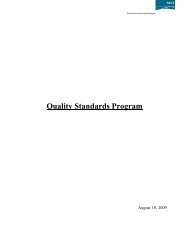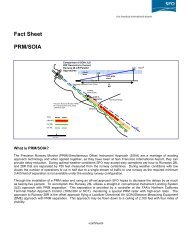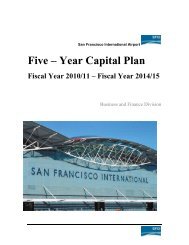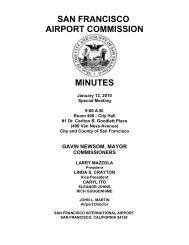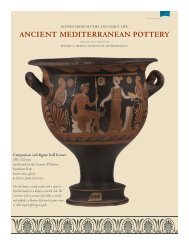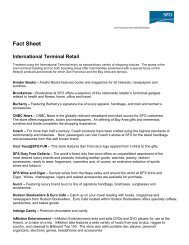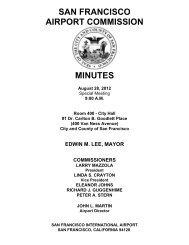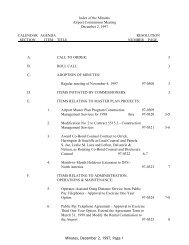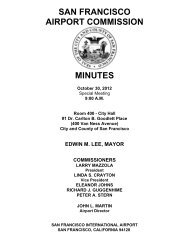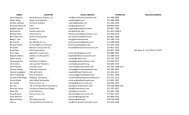Official Statement Airport Commission City and County of San ...
Official Statement Airport Commission City and County of San ...
Official Statement Airport Commission City and County of San ...
You also want an ePaper? Increase the reach of your titles
YUMPU automatically turns print PDFs into web optimized ePapers that Google loves.
long-term wage/inflation assumption <strong>and</strong> a long-term consumer price index assumption. At its November 2008<br />
meeting, after review <strong>of</strong> the analysis <strong>and</strong> recommendation prepared by the consulting actuarial firm, the Retirement<br />
Board reduced the long-term investment earnings assumption from 8.00% to 7.75%. The Retirement Board did not<br />
change the other two long-term economic assumptions, leaving the long-term wage/inflation assumption at 4.50%<br />
per annum <strong>and</strong> the consumer price index assumption at 3.25% per annum. These economic assumptions along with<br />
periodic demographic studies are utilized to prepare the valuation <strong>of</strong> the plan each year. The latest report as <strong>of</strong><br />
June 30, 2009 was issued in January 2010. Upon receipt <strong>of</strong> the consulting actuarial firm’s valuation report,<br />
Retirement System staff provides a recommendation to the Retirement Board as to the Retirement Board’s<br />
acceptance <strong>of</strong> the consulting actuary’s valuation report. In connection with such acceptance, the Retirement Board<br />
acts to set the annual employer contribution rates required by the Retirement System as detailed in the report.<br />
The actuary <strong>and</strong> the Retirement Board determine the actuarially required contribution amounts using three<br />
related calculations:<br />
First, the normal cost is established for the Retirement System. The normal cost <strong>of</strong> the system<br />
represents the portion <strong>of</strong> the actuarial present value <strong>of</strong> benefits that the Retirement System will be expected<br />
to fund that is attributable to a current year’s employment. The Retirement System uses the entry age<br />
normal cost method, which is an actuarial method <strong>of</strong> calculating the anticipated cost <strong>of</strong> pension liabilities,<br />
designed to fund promised benefits over the average future life <strong>of</strong> the Retirement System members.<br />
Second, the contribution calculation takes account <strong>of</strong> the amortization <strong>of</strong> a portion <strong>of</strong> the amount<br />
by which the actuarial value <strong>of</strong> Retirement System liabilities exceeds the actuarial value <strong>of</strong> Retirement<br />
System assets, such amount being known as an “unfunded accrued actuarial liability” or “UAAL.” If the<br />
actuarial value <strong>of</strong> assets exceeds the actuarial value <strong>of</strong> liabilities, the contribution amount is adjusted to<br />
reflect this excess by decreasing it in an amount equal to the excess <strong>of</strong> actuarial assets over actuarial<br />
liabilities, divided by the present value <strong>of</strong> projected salaries for the next 15 years.<br />
The UAAL is the difference between estimated liabilities <strong>and</strong> the value <strong>of</strong> smoothed plan assets<br />
<strong>and</strong> can be thought <strong>of</strong> as a snapshot <strong>of</strong> the funding <strong>of</strong> benefits as <strong>of</strong> the valuation date. There are a number<br />
<strong>of</strong> assumptions <strong>and</strong> calculation methods that bear on each side <strong>of</strong> this asset-liability comparison. On the<br />
asset side, the actuarial value <strong>of</strong> Retirement System assets is calculated using a five-year smoothing<br />
technique, so that gains or losses in asset value are recognized over that longer period rather than in the<br />
immediate time period such gain or loss is identified. As for calculating the pension benefit liability,<br />
certain assumptions must be made about future costs <strong>of</strong> pension benefits to generate an overall liability<br />
amount. If the Retirement System’s results are better or worse than the estimated UAAL, the result is<br />
called an actuarial gain or loss, respectively, <strong>and</strong> under the Actuarial Methods Policy <strong>of</strong> the Retirement<br />
Board any such gain or loss is amortized over a 15-year period. Similarly, if the estimated liabilities<br />
change due to changes in the aforementioned assumptions, the effect <strong>of</strong> such changes is also amortized over<br />
a 15-year period.<br />
Third, after calculating the normal cost <strong>and</strong> the adjustment for UAAL, the actuary amortizes<br />
supplemental costs for the various member benefit plans. Supplemental costs are additional costs resulting<br />
from the past service component <strong>of</strong> Retirement System benefit increases. In other words, when the Charter<br />
is amended to extend additional benefits to some or all beneficiaries <strong>of</strong> the Retirement System, the<br />
Retirement System’s payment liability is increased by the amount <strong>of</strong> the new benefit earned in connection<br />
with the service time already accrued by the then-current beneficiaries. These supplemental costs for each<br />
beneficiary are amortized over no more than 20 years.<br />
The actuary combines the three calculations described above to arrive at a total contribution<br />
requirement for funding the Retirement System in that fiscal year. This total contribution amount is<br />
satisfied from a combination <strong>of</strong> employer <strong>and</strong> employee contributions. Employee contributions are<br />
m<strong>and</strong>ated by the Charter. Sources <strong>of</strong> payment may be the subject <strong>of</strong> collective bargaining agreements with<br />
each union or bargaining unit. The employer contribution is established by Retirement Board action each<br />
year <strong>and</strong> is expressed as a percentage <strong>of</strong> salary applied to all wages covered under the Retirement System.<br />
81



